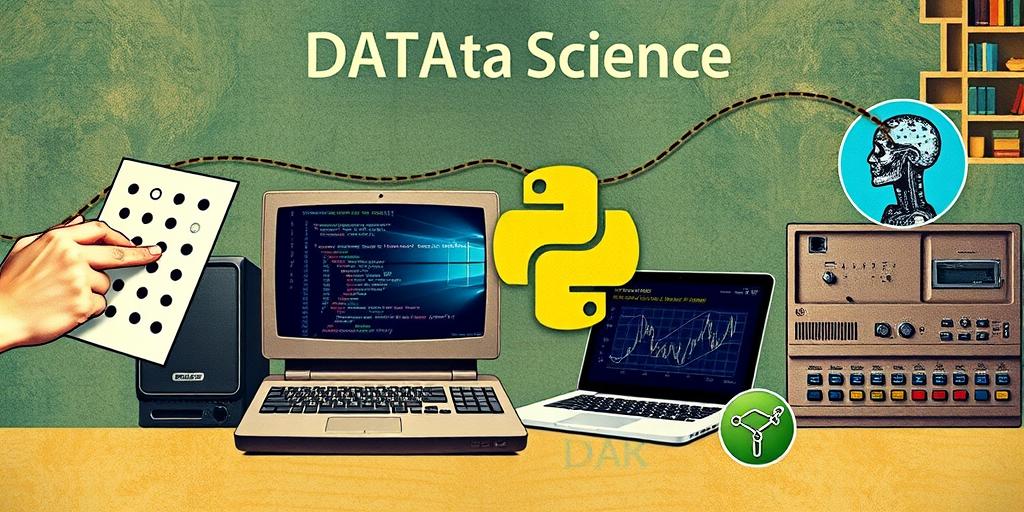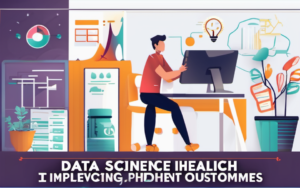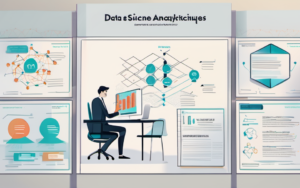The field of Data Science has undergone a remarkable transformation, evolving from its humble beginnings to the sophisticated discipline we know today. This journey, spanning decades, is a fascinating blend of technological advancements, statistical breakthroughs, and the ever-increasing availability of data. Let’s explore this captivating evolution.
1. The Genesis of Data Science
1.1 Early Computing and Punch Cards
The very origins of Data Science can be traced back to the early days of computing, a time dominated by cumbersome mechanical devices. Imagine a world where data was meticulously punched onto cards – each hole representing a bit of information. This laborious process, though primitive by today’s standards, laid the foundation for automated data processing. These early efforts, primarily focused on census data and other large-scale statistical analyses, highlight the foundational role of data management in the nascent field. The meticulous nature of this early data handling underscores the importance of accuracy and organization, principles that remain central to Data Science even now.
1.2 The Rise of Statistical Methods
Simultaneously, the field of statistics was flourishing. Pioneering statisticians developed sophisticated methods for analyzing data, laying the groundwork for many of the techniques used in modern Data Science. Think of the development of regression analysis, hypothesis testing, and other statistical models – these were crucial steps in the journey towards extracting meaningful insights from data. This period saw a focus on understanding patterns and making predictions based on available data, paving the way for the more complex models of today. The development of these statistical methods is a critical part of the history of data science and programming languages.
1.3 The Dawn of the Computer Age
The invention of the electronic computer revolutionized data processing. Suddenly, what once took days or weeks could be accomplished in hours or even minutes. This massive increase in processing power opened up entirely new possibilities for data analysis. The transition from manual calculations and punch cards to electronic computation marked a pivotal moment, allowing for the processing of significantly larger datasets and the development of more complex algorithms. This was the beginning of the evolution of data science tools and techniques, and it significantly impacted the development of the field.
2. The Evolution of Tools and Techniques
2.1 Mainframe Computing and Early Software
The early days of computer science witnessed the rise of mainframe computers, large and powerful machines that dominated the computing landscape. These systems, while expensive and resource-intensive, enabled the processing of vast amounts of data. Early software packages emerged, offering rudimentary capabilities for data manipulation and analysis. The limitations of these early systems, however, were significant. Access was often restricted, and the complexity of programming languages made data analysis accessible to only a select few. This highlights the significant impact of programming languages on data science development.
2.2 The Emergence of Statistical Packages (SAS, SPSS)
The development of dedicated statistical software packages, such as SAS and SPSS, marked a significant turning point. These tools provided user-friendly interfaces, simplifying the process of data analysis and making it accessible to a wider range of researchers and analysts. The introduction of these packages streamlined data manipulation, statistical modeling, and reporting, accelerating the adoption of statistical methods across various disciplines. The evolution of data science tools and techniques accelerated rapidly during this period.
2.3 The Relational Database Revolution
The invention of the relational database profoundly impacted Data Science. The ability to organize and query data efficiently using structured query language (SQL) enabled more sophisticated data management and analysis. The relational database model provided a structured approach to storing and retrieving data, facilitating more complex queries and analyses. This was a critical step in the transition from traditional to modern data science methods.
3. The Big Data Explosion and its Impact
3.1 The Growth of Data Volume and Variety
The advent of the internet and the proliferation of digital devices led to an explosion in the volume and variety of data. The sheer scale of this “Big Data” presented new challenges and opportunities for Data Science. Traditional methods struggled to keep pace with the ever-increasing flow of data. This necessitated the development of new tools and techniques capable of handling the scale and complexity of modern datasets. The growth of data volume and variety has been a defining characteristic of the modern era of data science.
3.2 The Hadoop Ecosystem and Distributed Computing
To address the challenges posed by Big Data, distributed computing frameworks like Hadoop emerged. Hadoop enabled the processing of massive datasets across clusters of computers, overcoming the limitations of single-machine processing. This approach significantly advanced the capabilities of data science. It allowed analysts to work with datasets that were previously unmanageable, furthering the evolution of data science tools and techniques.
3.3 Cloud Computing and Scalable Data Storage
Cloud computing has revolutionized data storage and processing. Cloud platforms provide scalable and cost-effective solutions for storing and analyzing massive datasets. This accessibility further democratized Data Science, allowing researchers and businesses of all sizes to leverage the power of data analysis. The scalability and cost-effectiveness of cloud computing have been crucial to the advancement of data science through the decades.
4. The Rise of Machine Learning and AI
4.1 Supervised, Unsupervised, and Reinforcement Learning
Machine learning, a subfield of AI, has become a cornerstone of modern Data Science. Different types of machine learning, such as supervised learning (predicting outcomes based on labeled data), unsupervised learning (discovering patterns in unlabeled data), and reinforcement learning (learning through trial and error), are utilized to solve a vast array of problems. The development of these algorithms has fundamentally changed how we approach data analysis and problem-solving.
4.2 Deep Learning and Neural Networks
Deep learning, a powerful subset of machine learning, utilizes artificial neural networks with multiple layers to extract complex patterns from data. Deep learning has achieved remarkable success in areas like image recognition, natural language processing, and speech recognition. The advancements in deep learning have significantly accelerated the progress of data science advancements through the decades.
4.3 Natural Language Processing and Computer Vision
Natural Language Processing (NLP) and Computer Vision are two rapidly evolving fields within AI that are significantly impacting Data Science. NLP enables computers to understand and process human language, while computer vision allows computers to “see” and interpret images and videos. These technologies are transforming various industries, opening up new opportunities for data-driven insights.
5. Modern Data Science with Python
5.1 Popular Python Libraries (Pandas, NumPy, Scikit-learn)
Python has emerged as the dominant programming language for Data Science due to its versatility, ease of use, and extensive libraries. Pandas provides powerful tools for data manipulation and analysis, NumPy offers efficient numerical computation capabilities, and Scikit-learn provides a comprehensive suite of machine learning algorithms. The combination of these libraries makes Python an ideal tool for various data science tasks.
5.2 Data Visualization Tools (Matplotlib, Seaborn)
Effective data visualization is crucial for communicating insights derived from data analysis. Python libraries like Matplotlib and Seaborn provide versatile tools for creating informative and visually appealing charts and graphs. These tools allow Data Scientists to effectively convey complex data patterns to both technical and non-technical audiences. This is crucial for presenting findings and making data-driven decisions.
5.3 Building and Deploying Data Science Models
Python also offers robust tools for building and deploying machine learning models. Frameworks like TensorFlow and PyTorch facilitate the development and training of complex neural networks. Deployment tools enable the integration of models into applications and systems, allowing for real-world implementation of data-driven solutions. This integration is crucial for translating analytical findings into actionable insights.
6. The Future of Data Science
6.1 Ethical Considerations and Responsible AI
As Data Science becomes increasingly influential, addressing ethical considerations and promoting responsible AI development is paramount. Bias in data and algorithms, privacy concerns, and the potential for misuse are critical issues that need careful attention. The future of Data Science hinges on developing and deploying AI ethically and responsibly.
6.2 Emerging Technologies and Trends
The field of Data Science continues to evolve rapidly. Emerging technologies, such as quantum computing, edge computing, and advancements in AI, will significantly shape the future of the field. Staying abreast of these developments is crucial for Data Scientists to remain at the forefront of innovation.
6.3 The Role of Data Science in Various Industries
Data Science is transforming industries across the board, from healthcare and finance to manufacturing and retail. The ability to extract insights from data is driving innovation and efficiency across diverse sectors. As data continues to grow in volume and complexity, the role of Data Science in various industries will only continue to expand. The future promises even greater integration of data-driven decision-making across a wide range of human endeavors. The journey of Data Science continues, and its future is bright, filled with exciting possibilities and challenges that will shape our world in profound ways.




